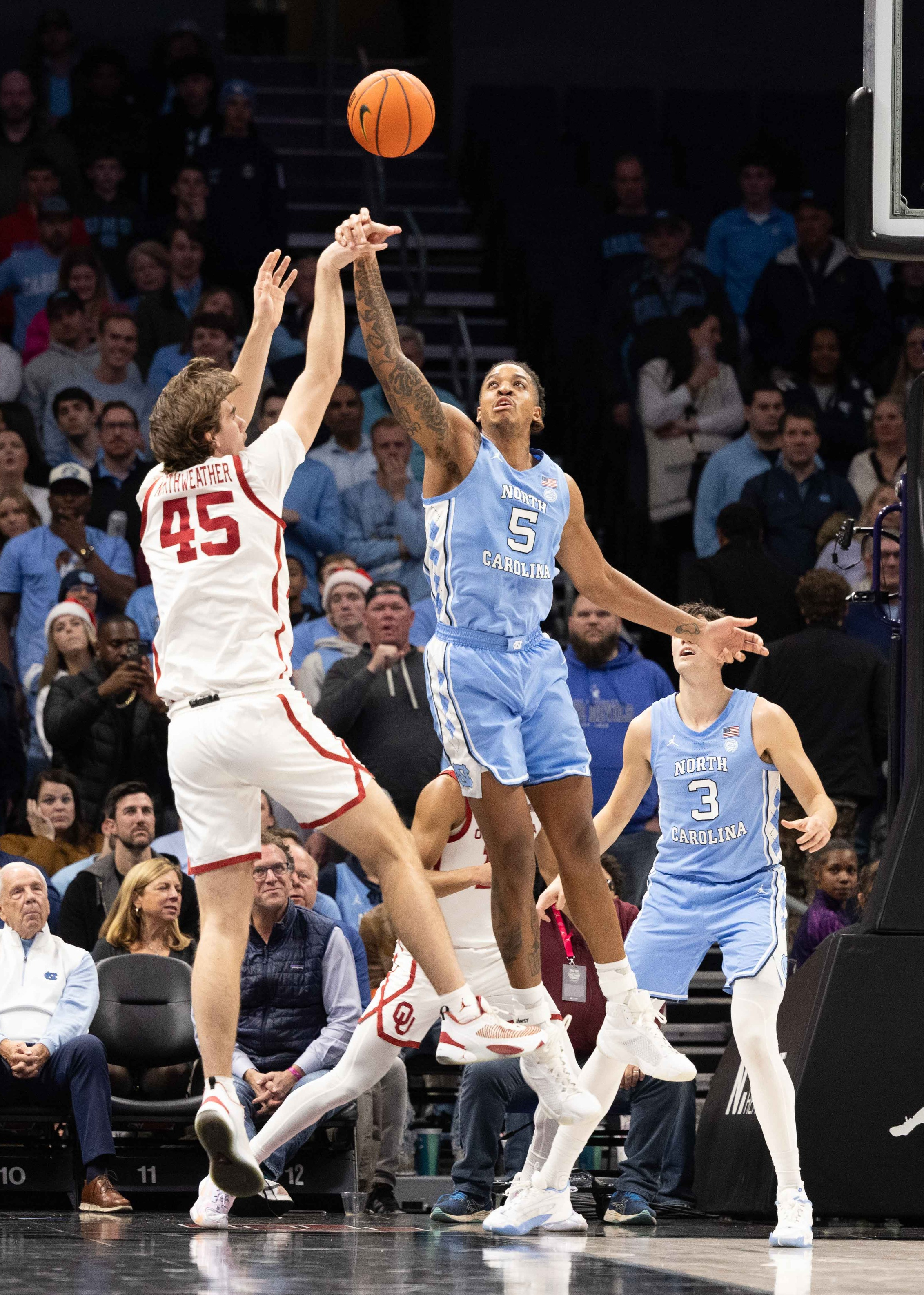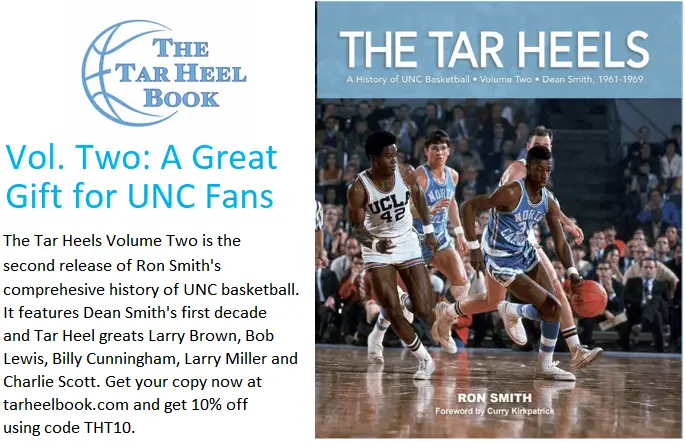By Andrew Kurzeja
Ahead of the final game before the holiday break, North Carolina had its hands full trying to prepare for an Oklahoma Sooners offense, led by sophomore guard Otega Oweh and junior guard Javian McCollum.
Oklahoma coach Porter Moser has garnered a reputation for himself over the past several years as one of the brightest and most innovative minds in college basketball on the offensive end of the floor. The results this season have reinforced that narrative. The Sooners came into Wednesday night’s contest averaging over 1.00 points per possession, good enough for a top 35 spot in the nation, according to Synergy Sports.
No. 11 North Carolina ended up winning the game and, in doing so, held No. 7 Oklahoma to its lowest point and possession totals of the season. Moser’s usual free-flowing motion offense was noticeably stagnant for much of the evening.
Let’s look at what strategies Carolina coach Hubert Davis employed on the defensive end and how they were able to take the 10-0 Sooners out of their normal rhythm.
Keeping the ball on the sideline
A good way to judge a team’s defensive game plan is how it chooses to defend ball screens. They’re a massive element of just about every team’s offense today, and defending them is certainly a priority when you’re going up against a guard-heavy offense like Oklahoma.
From the opening tip, it was evident that the Tar Heels’ plan of attack was to force the ball away from the middle of the floor as often as possible.
Carolina would go to their “ice” coverage on any ball screen set on the wing or in the corner. This strategy involves the defender guarding the basketball (RJ Davis in this example) angling himself toward the sideline, and forcing the handler away from the screen to keep the ball on the same side of the floor.
Meanwhile, the defender guarding the screener will be dropped down into the paint to contain the baseline drive. Some teams will even call this “down” coverage because they’re sending the ball down toward the baseline.
Teams set these screens in the first place because the middle of the floor is a premium spot for any offense. The handler has a clear vision of all his passing options, and any pass made would be coming from a shorter distance, making any help scheme exponentially more difficult. Think of it like putting your best wide receiver in the slot position in football. He can break inside or outside without worrying about getting pinned against the sideline, and the ball will be in the air for a shorter period.
The other benefit of “ice” is that you can defend the ball screen with just the two players involved in the screening action without switching. Contrast that to coverage like hard hedging, which requires a third defender to rotate and “tag” the roll to the basket.
Oklahoma tried getting North Carolina guard Cormac Ryan out of position on this possession by running him through a pair of screens before re-screening back toward the middle. However, the Notre Dame transfer does a really impressive job of getting through the screens without much issue and still getting to the high side of the re-screen to funnel the ball back into Armando Bacot.
Here, you can see all of these concepts working together in harmony to completely stall out Oklahoma’s offense. Davis is able to “ice” the first screen toward the sideline, then Seth Trimble is able to do the same thing once Oklahoma tries to flow into a dribble handoff before sending the ball baseline a second time once the Sooners try to re-screen. It completely stalls out an offense that is predicated on middle penetration and changing sides of the floor.
Switching and the value of Bacot
For all of the benefits of keeping the ball on the sideline, there will obviously be times when keeping the ball out of the middle of the floor is unavoidable. If a screen is set out at the top of the key, there is no way to send it toward the baseline. For these situations, you need a new solution.
On Wednesday night, North Carolina opted to just switch any ball screen set in the middle of the floor. Switching has its benefits and drawbacks. While it does keep a hat on a hat, so to speak, it can be prone to severe mismatches either in the post or out on the perimeter. For this to work, Carolina’s defenders would have to hold their own while guarding out of position for long stretches of possessions.
Watch UNC switch this screening action with Bacot taking McCollum out on the perimeter and Ryan switching on to Oklahoma forward Luke Northweather.
Seeing Ryan would be at a size disadvantage on any post-up opportunity, Harrison Ingram executes a “scram” switch by kicking Ryan back out to the perimeter while Ingram takes on Northweather, minimizing any potential advantage in the post. Golden State Warriors coach Steve Kerr is revered for using this tactic to protect Steph Curry over the years in what they call a “bump off.”
The only remaining issue is that Bacot is still switched on to McCollum and would theoretically be at a major speed disadvantage. But once McCollum throws the ball to the corner, there’s a pretty good chance that he will immediately receive the ball back to attack Bacot with a live dribble. Bacot knows this, so he’s super aggressive about denying the ball back to McCollum, going nearly all the way out to the logo to do so. Even when McCollum does get it back, the shot clock is nearly empty and he’s forced to attack into a sea of blue jerseys.
But more often than not, Bacot was going to be on an island with either McCollum or Oweh for most of the night and, to his credit, he did a masterful job of moving to contain the quicker guards and keep the ball out of the paint.
Having a 5-man like Bacot who can step out and defend on the perimeter like this is vital for any defense and negates a lot of the issues you’d normally see with traditional coverages.
Here’s a blend of both coverages where Bacot drops back to contain the ball in their “ice” coverage before switching a different screen in the middle of the floor in just a matter of seconds.
Effort plays rewarded
I did want to highlight a couple of other plays from this game that directly or indirectly influenced the outcome of a possession, based purely on the effort Carolina used to disrupt things.

Take this play, for example — Oklahoma is running a play with McCollum receiving a backscreen toward the corner for a baseline drift pass. Given that Ryan doesn’t appear to recognize the screen coming, this likely would have been a pretty good look at a three that could have cut UNC’s lead down to just six with a minute to play.
But Trimble makes the initial catch for Oweh really difficult, and Oweh has to catch it a lot closer to the baseline than he wanted, and eventually, he just runs out of room, and it’s a turnover.
I also wanted to highlight this pure hustle play by Davis to get back into the play and get a steal.
What we learned
UNC’s ability to defend Oklahoma one-on-one was a huge factor in a game that saw the Tar Heels force 18 turnovers and hold McCollum in particular to a subpar shooting performance.
Bacot’s ability to defend out in space is a major weapon for North Carolina if the Tar Heels decide to switch certain screening actions.
Hubert Davis’ game plan to keep the ball on the sideline was also key in throwing a wrench into Oklahoma’s typical flow. We’ll see if they employ it again.
Andrew Kurzeja is a video coordinator with seven years of basketball coaching experience at the high school and collegiate levels. He also contributes to Carmichael Radio, a podcast dedicated to the North Carolina women’s basketball team. You can find him on X (formerly Twitter) at @AndrewKurzeja.
Photo by Smith Hardy




The other thing I noticed the Tar Heels doing is that on the rare occasions when OU got the ball into the paint on the dribble, they typically forced the penetration high in the lane and defenders near the free throw line would cheat in and swat the ball from the dribbler while the main defender was preventing the penetration. “Active hands” they often call it. A very NBA tactic.
LikeLike